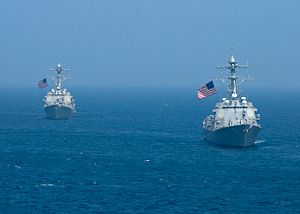Realizing the strategic importance of the South China Sea (SCS) in its “rebalancing” policy, the United States in 2015 took several specific actions to challenge China’s maritime claims in the region. Doctrinally, the Defense Department released the Asia-Pacific Maritime Security Strategy, which described China as the major source of instability, and articulated U.S. efforts to stabilize the SCS. Operationally, Washington deployed the USS Lassen (DDG-82) to transit inside the 12-nautical miles of five features including Subi Reef, and flew B52 bombers near a group of Chinese-built artificial islands in the Spratlys.
To some extent, these steps show that the U.S. has tried to adopt a more proactive posture in the SCS. However, they will not be sufficient to deter Chinese coercion in the region. Further action is needed.
Certainly the U.S. needs to make some careful calculations when it comes to policy dealing with a would-be regional hegemon, but it also needs to be decisive and timely. The concept of “fly and sail” was first mentioned in May 2015, and was repeatedly announced by top U.S. leaders at various levels (here, here, here), but the White House agonized for too long before deciding to send the USS Lassen on its mission on October 27, 2015. Such a slow response is unacceptable for a global power, and prompts widespread charges of American weakness. It gives China the opportunity to mastermind its reaction to ensure that U.S. efforts are in vain. For example, in response to the “fly and sail” campaign, China has recently conducted a series of civilian test flights to the Fiery Cross Reef, violating the Convention on International Civil Aviation and the sovereignty of other coastal states, including Vietnam, and paving the way for the future militarization in the SCS.
Diplomatically, the U.S. needs to upgrade diplomatic ties with new Southeast Asian partners, especially Vietnam, to a strategic partnership. This is important for several reasons. First, a strategic partnership will help reduce friction over issues such as democracy and human rights, which in the view of some countries in the region could undermine their political system and territorial sovereignty. In fact, Southeast Asia has made some significant progress in these areas in recent years, and this will continue.
Second, when strategic ties are established, “strategic trust” will increase, opening up the possibility for further strategic and defense cooperation.
Third and more importantly, if the U.S. is not assertive enough to seek more close friends in the region, it will lose ground to China. Beijing is also investing resources to reassure and appease Southeast Asian countries through initiatives such as the Asian Infrastructure Investment Bank, Maritime Silk Road, and the Silk Road Fund.
Economically, the U.S. should consider two more initiatives. First, while the Trans-Pacific Partnership has the potential to usher in a new chapter of U.S. economic engagement with Asia, the U.S. should consider building an American maritime trade road, one that knits and links the U.S. with commercial ports in the region. This is significant because “almost 30 percent of the world’s maritime trade transits the South China Sea annually, including approximately $1.2 trillion in ship-borne trade bound for the U.S.” More American merchant marine ships sailing back and forth in the South China Sea would provide the U.S. with a greater presence, and one that is soft, legitimate, and easily accepted since trade is win-win.
Second, the U.S. needs to back its oil companies to establish a joint venture (or a consortium, which includes oil companies from like-minded countries) to explore oil and gas within the smaller claimants’ exclusive economic zone (EEZ) and continental shelf, particularly in sensitive areas where the Chinese 9-dash line may overlap. In doing so, the U.S. will not only bolster its interoperability with the smaller claimants, but also weaken Chinese excessive maritime claims in the SCS because the exploration projects are in compliance with international law – within the smaller claimants’ jurisdictional maritime zones in accordance with the UNCLOS, but very distant from Chinese territory.
In the meantime, the U.S. might draw more attention to the fact that it is the foreign investment flow into China and demand for Chinese exports that have been creating the revenue that has enabled China to be assertive in the South China Sea and beyond. The decades since China adopted its policy of greater openness in 1978 have seen it rely heavily on Western capital and technology to develop. However, on becoming the world’s second largest economy, China changed direction and became a revisionist and expansionist power.
Militarily, if Beijing uses paramilitary and maritime militia vessels to harass the operations of American oil giants, Washington with the host countries’ consent could dispatch its coast guard with the navy on the horizon and aircraft in the sky to protect its economic interests. On the one hand, this would give the U.S. Navy more toeholds in the region, but would avoid sparking international confrontation with the use of warships. On the other hand, this action would uphold the international law in practice, and effectively demonstrate that the 9-dash line is invalid and inconsistent with UNCLOS. To be able to make this real, however, the U.S. Coast Guard needs to be expanded at appropriate levels to afford missions in the SCS, because most USCG vessels are already tasked with surveillance over the vast American EEZ and in the Arctic.
In sum, if it is to deter Chinese coercion in the South China Sea, the U.S. needs to be strong and act more comprehensively.
Thuc D. Pham is a SCS researcher at the Diplomatic Academy of Vietnam. The opinions expressed in the article are those of the author and do not represent the views of institutions to which the author is attached.

































